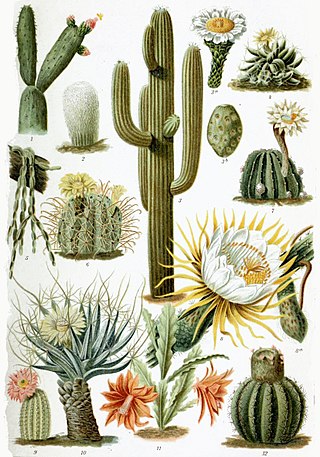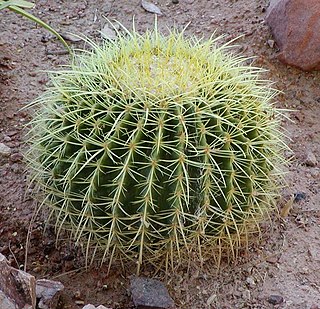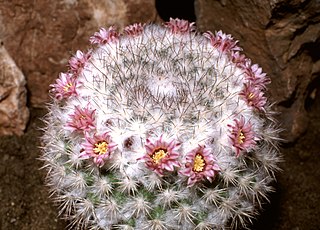Related Research Articles

A cactus is a member of the plant family Cactaceae, a family of the order Caryophyllales comprising about 127 genera with some 1,750 known species. The word cactus derives, through Latin, from the Ancient Greek word κάκτος (káktos), a name originally used by Theophrastus for a spiny plant whose identity is now not certain. Cacti occur in a wide range of shapes and sizes. They are native to the Americas, ranging from Patagonia in the south to parts of western Canada in the north, with the exception of Rhipsalis baccifera, which is also found in Africa and Sri Lanka. Cacti are adapted to live in very dry environments, including the Atacama Desert, one of the driest places on Earth. Because of this, cacti show many adaptations to conserve water. For example, almost all cacti are succulents, meaning they have thickened, fleshy parts adapted to store water. Unlike many other succulents, the stem is the only part of most cacti where this vital process takes place. Most species of cacti have lost true leaves, retaining only spines, which are highly modified leaves. As well as defending against herbivores, spines help prevent water loss by reducing air flow close to the cactus and providing some shade. In the absence of true leaves, cacti's enlarged stems carry out photosynthesis.

Barrel cacti are various members of the two genera Echinocactus and Ferocactus, endemic to the deserts of Southwestern North America southward to north central Mexico. Some of the largest specimens are found in the Sonoran Desert.

Mammillaria is one of the largest genera in the cactus family (Cactaceae), with currently 200 known species and varieties recognized. Most of the mammillarias are native to Mexico, while some come from the Southwestern United States, the Caribbean, Colombia, Guatemala, Honduras and Venezuela. The common name "pincushion cactus" refers to this genus and the closely-related Escobaria.

Ariocarpus is a small genus of succulent, subtropical plants of the family Cactaceae.

Cacteae is a tribe of plants of the family Cactaceae found mainly in North America especially Mexico. As of August 2018, the internal classification of the family Cactaceae remained uncertain and subject to change. A classification incorporating many of the insights from the molecular studies was produced by Nyffeler and Eggli in 2010. The main threats to cactus species are poaching, farming, mining developments, and climate change.

Ariocarpus fissuratus is a species of cactus found in small numbers in northern Mexico and Texas in the United States. Common names include living rock cactus, false peyote, chautle, dry whiskey and star cactus.

Kroenleinia grusonii, popularly known as the golden barrel cactus, golden ball, "mother-in-law's cushion" or "mother-in-law’s chair", is a species of barrel cactus which is endemic to east-central Mexico.

Cochemiea dioica, also called the strawberry cactus, California fishhook cactus, strawberry pincushion or fishhook cactus, is a cactus species of the genus Cochemiea. Its common name in Spanish is biznaga llavina. Temperature along with precipitation are consequential factors in distributing plant species.
The Cactus and Succulent Society of America (CSSA) is a horticultural society which is based in Pasadena, California.

The Desert Garden Conservatory is a large botanical greenhouse and part of the Huntington Library, Art Collections and Botanical Gardens, in San Marino, California. It was constructed in 1985. The Desert Garden Conservatory is adjacent to the 10-acre (40,000 m2) Huntington Desert Garden itself. The garden houses one of the most important collections of cacti and other succulent plants in the world, including a large number of rare and endangered species. The 3,000-square-foot (280 m2) Desert Garden Conservatory serves The Huntington and public communities as a conservation facility, research resource and genetic diversity preserve. John N. Trager is the Desert Collection curator.

In botany, succulent plants, also known as succulents, are plants with parts that are thickened, fleshy, and engorged, usually to retain water in arid climates or soil conditions. The word succulent comes from the Latin word sucus, meaning "juice" or "sap".

The Huntington Desert Garden is part of The Huntington Library, Art Collections and Botanical Gardens in San Marino, California. The Desert Garden is one of the world's largest and oldest collections of cacti, succulents and other desert plants, collected from throughout the world. It contains plants from extreme environments, many of which were acquired by Henry E. Huntington and William Hertrich in trips taken to several countries in North, Central and South America.

Mammillaria spinosissima, also known as the spiny pincushion cactus, is a species of flowering plant in the cactus family Cactaceae, endemic to the central Mexican states of Guerrero and Morelos, where they grow at elevations of approximately 1,600 to 1,900 metres. The species was described in 1838 by James Forbes, gardener of the Duke of Bedford. Botanist David Hunt collected a specimen in 1971, when he located one near Sierra de Tepoztlan, Mexico.

Many cacti are known to be psychoactive, containing phenethylamine alkaloids such as mescaline. However, the two main ritualistic (folkloric) genera are Echinopsis, of which the most psychoactive species occur in the San Pedro cactus group, and Lophophora, with peyote being the most psychoactive species. Several other species pertaining to other genera are also psychoactive, though not always used with a ritualistic intent.

Erich Werdermann was a German botanist.

Pelecyphora sneedii is a rare species of cactus known by the common names Sneed's pincushion cactus and carpet foxtail cactus. It is endemic to the Chihuahuan Desert of the southwestern United States and northwestern Mexico. It is a small, variable cactus with a lengthy taxonomic history, and is often subdivided into a number of subspecies or varieties. It is usually found on steep, rocky habitats, primarily of limestone geology, in desert scrub or coniferous forest. A species of conservation concern, P. sneedii faces threats from poaching, urban encroachment, and wildfires.
Robert Runyon was an American photographer, botanist, and politician who served as the mayor of Brownsville, Texas from 1941 to 1943.

Heinrich Poselger was a German botanist who specialized in studies of succulent plants.

Mammillaria bocasana is a species of cactus in the subfamily Cactoideae. It is often sold as a "powder puff" cactus, and also as a "Powder Puff Pincushion." The plant is protected from collecting in the wild in Mexico.

Gordon Douglas Rowley (1921–2019) was a British botanist and writer specialising in cacti and succulents.
References
- 1 2 3 4 5 Cactus Store (2021). Xerophile: Cactus Photographs from Expeditions of the Obsessed (Revised ed.). Ten Speed Press. pp. 331–333. ISBN 9781984859341.
- 1 2 3 4 Brown, Eryn (2005-09-29). "He knows their every spine". Los Angeles Times. Retrieved 2024-03-14.
- 1 2 3 "Thorny Issues" (PDF). Sacramento Cactus & Succulent Society. 57 (7): 2. July 2016.
- ↑ Palermo, Dave (1986-05-30). "Rare Plants From Mexico : 9 Indicted in Cacti Smuggling". Los Angeles Times. Retrieved 2024-04-30.
- ↑ "Cacti Collectors Fined" (PDF). Traffic Bulletin. 8 (3): 35. 4 November 1986.
- 1 2 3 "Woody Minnich | March 1st Speaker". Gates Cactus and Succulent Society. 2023-02-24. Retrieved 2024-03-14.
- 1 2 Woody Minnich - Bromeliads in the Americas - Sept 5, 2015 - Part One , retrieved 2024-03-14
- ↑ "Inside the Indiana Jones-like World of Cactus Explorers". PBS SoCal. 2017-08-25. Retrieved 2024-03-14.
- ↑ "Brief Biography of Wendell S. (Woody) Minnich" (PDF). New Mexico Cactus Society. 2011.
- ↑ "THE XEROPHILE, April–June 2020" (PDF). Cactus & Succulent Society of New Mexico. 2020. p. 7.
- ↑ Minnich, Woody (2017). "Cacti and other Succulents of Mexico" – via CSSA.